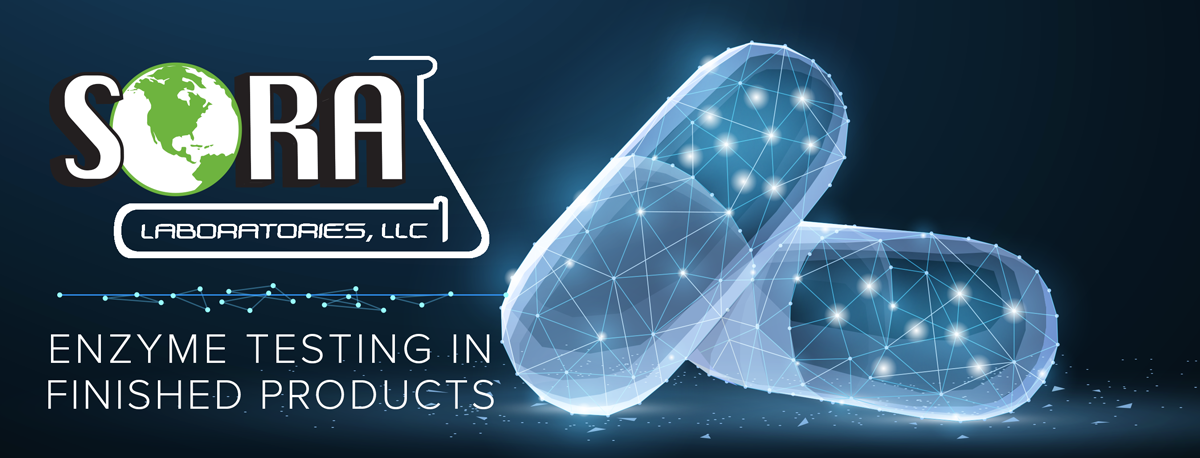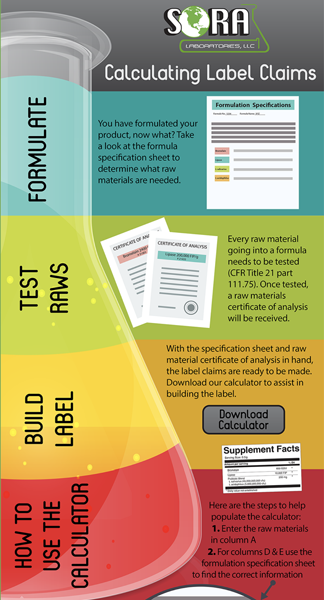SORA Labs has been testing enzyme activity assays and probiotic enumeration for more than 30 years. In fact, we were the first lab to add enzyme activity assays to an ISO/ICE 17025:2015 scope of accreditation in the U.S. Most of the methods we use come from the USP/FCC, BP, JP and other compendia, which are designed for raw material testing. One question we hear frequently is if it’s possible to test enzyme activities in finished products containing an enzyme blend. The answer is YES! We can test enzymes in finished products, however, like most analyses, it’s not as straight forward as raw material testing. Based on these experiences, we have put together a list of common interferences seen with finished product enzyme testing.
1) Combined Protease Effect: This occurs when several proteases are mixed together in a single blend. The protease activity of each enzyme is magnified by synergistic effects and boosts the protease activity. Enzymes are standardized to a single activity but may have other non-standardized activities present. These non-standardized activities are called side activities and can cause the proteases to show higher than expected results.
2)Enzyme/Carbohydrate Interference: The most common observation of this phenomena is with lactase but can be seen with other enzymes also. Lactase results often fall below label claims because of carbohydrates in the blend.
3) pH Co-Ingredient Interference: Enzyme activity assays are pH and temperature- controlled reactions. When the assay conditions are altered, the reaction may be affected, and the method may not perform correctly. Ingredients like betaine HCl, lemongrass, calcium carbonate, ox bile, and other high or low pH ingredients may swing the pH of the reaction solution outside the ideal method pH. Sometimes adjustments can be made to allow the reaction to run, but this is not always the case.
4) UV Co-Ingredient Interference: Many enzyme activity assays have a UV-Vis endpoint. If botanicals or other chemical ingredients are included in the enzyme matrix finished product, these ingredients may cause UV interferences. Methods that look for a change in UV absorbance could show inaccurate readings if these co-ingredients have similar UV characteristics.
Providing as much information about your product before testing begins will help determine possible interfering ingredients. When a testing lab is an extension of your team, you have a tremendous asset, because all these interference scenarios can be proven with testing.
We often use small sized, formulation-specific, lab blends, which allow us to remove the interfering ingredient(s) and then test the activity again. If the recovery is improved and the results meet label claims, then the product interference is confirmed.
We can also perform spike studies and measure the recovery of a known enzyme spike. Adding a known amount of enzyme into the finished blend and then testing for activity, will help determine the interference. When only partial recovery of the spike is observed, then this shows that there is interference with the testing.
Getting the blend testing and interferences figured out at the product development stage is very important to preventing product delays later in the process. Once products are ready to be shipped, then it is often a stressful scramble to understand why label claims are not being met. SORA Labs is here to help! Let us test your products so you can understand any interferences that are present. Remember, understanding your product’s unique characteristics early on, will help set the stage for successful manufacturing and sales.
SORA Labs January 2018 Newsletter
Calculating Label Claims
Formulate
You have formulated your product, now what? Take a look at the formula specification sheet to determine what raw materials are needed.
Test Raws
Every raw material going into a formula needs to be tested (CFR Title 21 part 111.75). Once tested, a raw materials certificate of analysis will be received.
Build Label
With the specification sheet and raw material certificate of analysis in hand, the label claims are ready to be made. Download our calculator to assist in building the label.
How To Use The Calculator
Here are the steps to help populate the calculator:
- Enter the raw materials in column A
- For columns D & E use the formulation specification sheet to find the correct information
- Activity claim and activity units for columns B & C can be found on the raw material certificate of analysis or specification sheet
- Columns G & H are the target specifications for the finished product. This information is used to create the label and is also what you include on the sample submission form for testing the finished product


